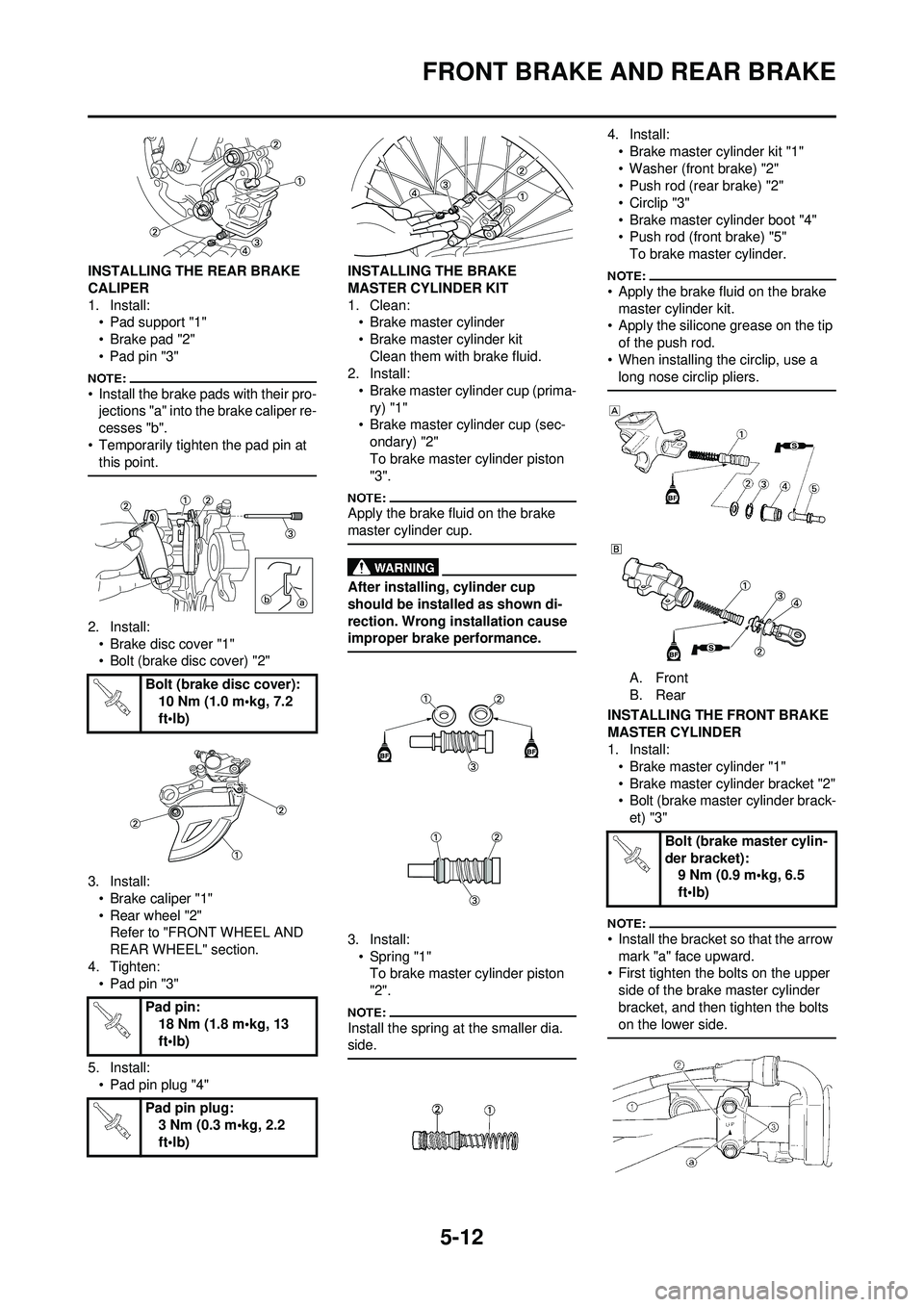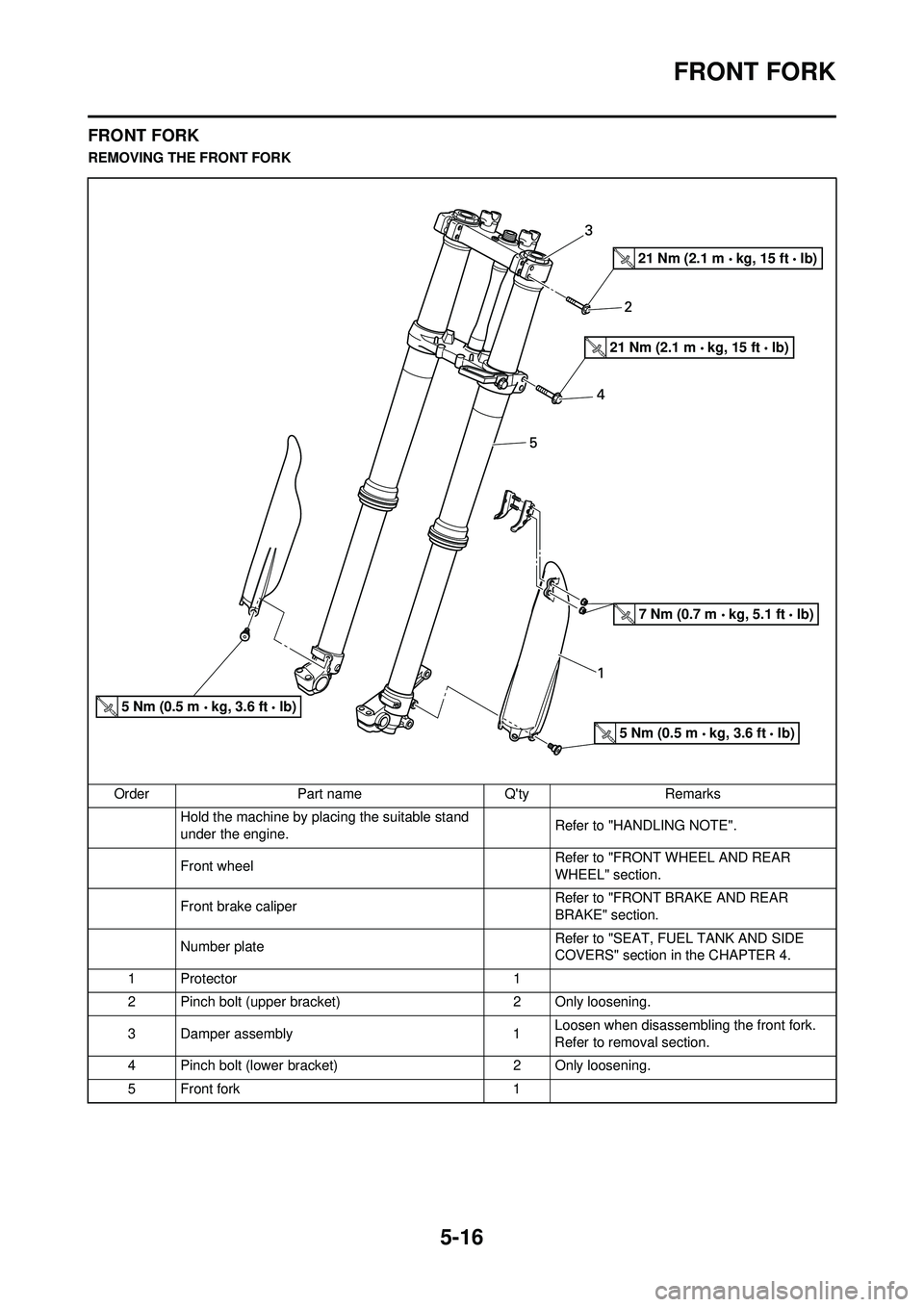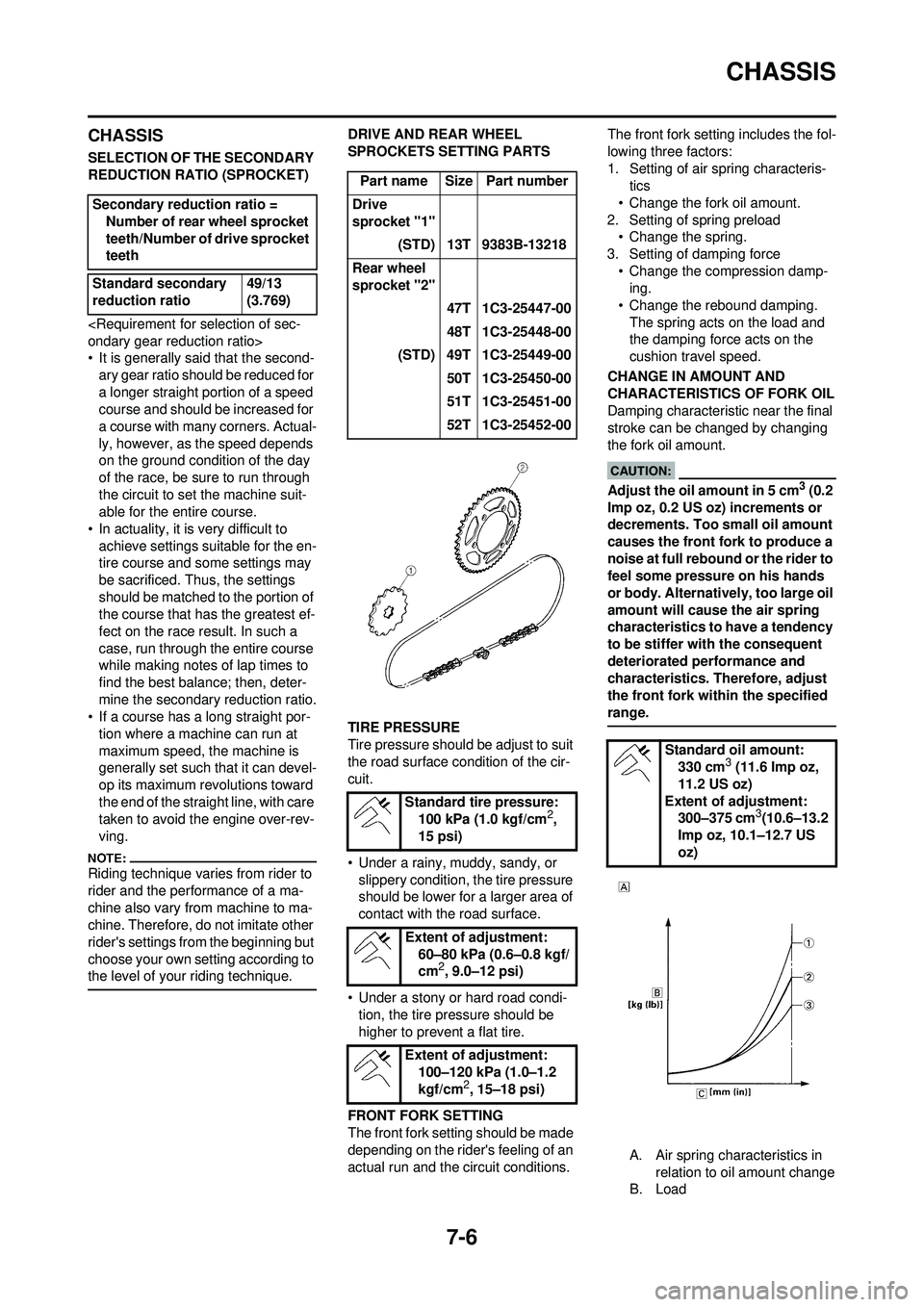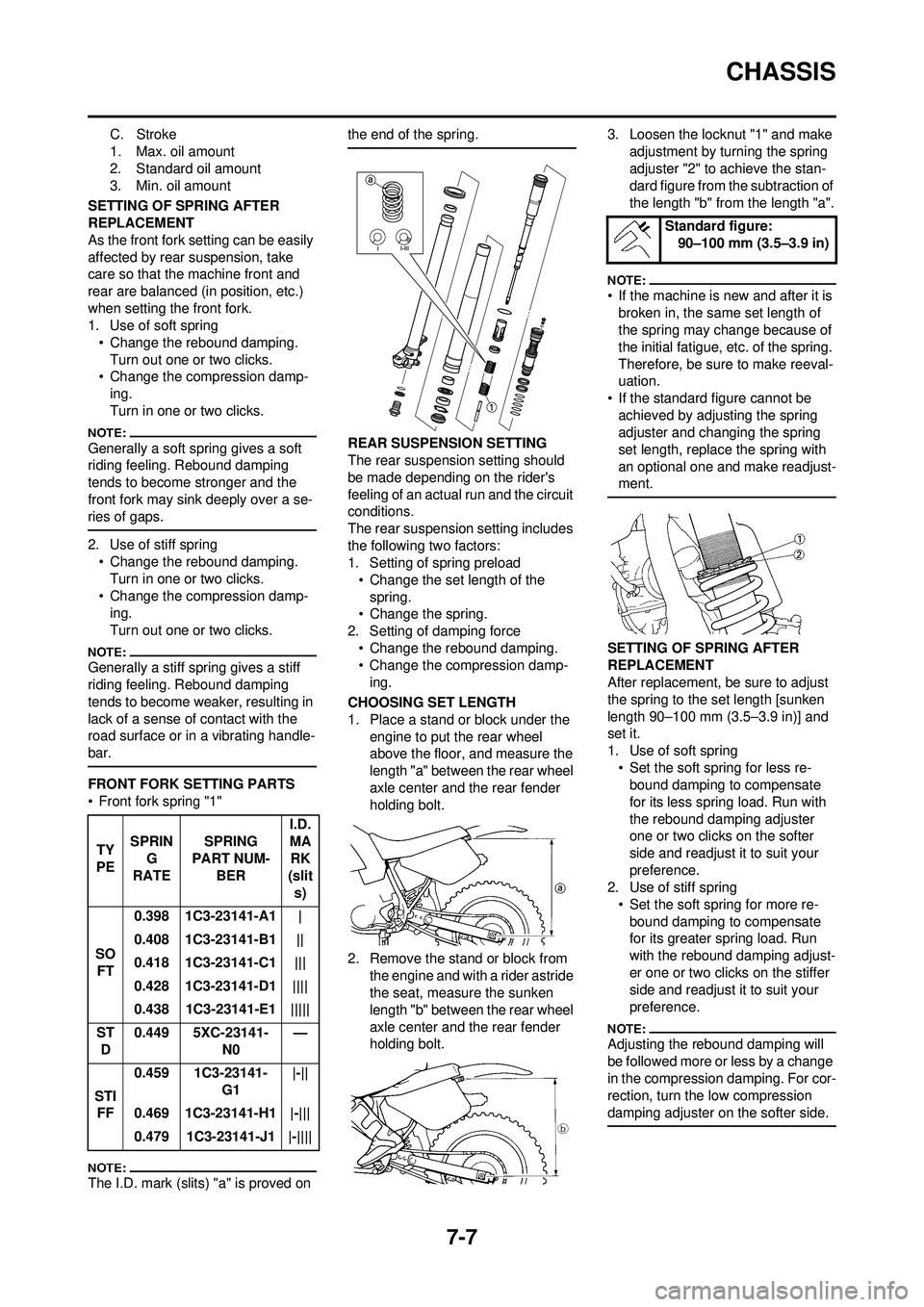wheel YAMAHA YZ250F 2008 Owner's Guide
[x] Cancel search | Manufacturer: YAMAHA, Model Year: 2008, Model line: YZ250F, Model: YAMAHA YZ250F 2008Pages: 192, PDF Size: 7.03 MB
Page 144 of 192

5-12
FRONT BRAKE AND REAR BRAKE
INSTALLING THE REAR BRAKE
CALIPER
1. Install:• Pad support "1"
• Brake pad "2"
• Pad pin "3"
• Install the brake pads with their pro-jections "a" into the brake caliper re-
cesses "b".
• Temporarily tighten the pad pin at this point.
2. Install:
• Brake disc cover "1"
• Bolt (brake disc cover) "2"
3. Install: • Brake caliper "1"
• Rear wheel "2"Refer to "FRONT WHEEL AND
REAR WHEEL" section.
4. Tighten: • Pad pin "3"
5. Install: • Pad pin plug "4" INSTALLING THE BRAKE
MASTER CYLINDER KIT
1. Clean:
• Brake master cylinder
• Brake master cylinder kit
Clean them with brake fluid.
2. Install:
• Brake master cylinder cup (prima-ry) "1"
• Brake master cylinder cup (sec-
ondary) "2"
To brake master cylinder piston
"3".
Apply the brake fluid on the brake
master cylinder cup.
After installing, cylinder cup
should be installed as shown di-
rection. Wrong installation cause
improper brake performance.
3. Install:• Spring "1"To brake master cylinder piston
"2".
Install the spring at the smaller dia.
side.
4. Install:
• Brake master cylinder kit "1"
• Washer (front brake) "2"
• Push rod (rear brake) "2"
•Circlip "3"
• Brake master cylinder boot "4"
• Push rod (front brake) "5"To brake master cylinder.
• Apply the brake fluid on the brake master cylinder kit.
• Apply the silicone grease on the tip
of the push rod.
• When installing the circlip, use a long nose circlip pliers.
A. Front
B. Rear
INSTALLING THE FRONT BRAKE
MASTER CYLINDER
1. Install: • Brake master cylinder "1"
• Brake master cylinder bracket "2"
• Bolt (brake master cylinder brack-et) "3"
• Install the bracket so that the arrow mark "a" face upward.
• First tighten the bolts on the upper
side of the brake master cylinder
bracket, and then tighten the bolts
on the lower side.
Bolt (brake disc cover): 10 Nm (1.0 m•kg, 7.2
ft•lb)
Pad pin: 18 Nm (1.8 m•kg, 13
ft•lb)
Pad pin plug: 3 Nm (0.3 m•kg, 2.2
ft•lb)
Bolt (brake master cylin-
der bracket):9 Nm (0.9 m•kg, 6.5
ft•lb)
Page 148 of 192

5-16
FRONT FORK
FRONT FORK
REMOVING THE FRONT FORKOrder Part name Q'ty Remarks Hold the machine by placing the suitable stand
under the engine. Refer to "HANDLING NOTE".
Front wheel Refer to "FRONT WHEEL AND REAR
WHEEL" section.
Front brake caliper Refer to "FRONT BRAKE AND REAR
BRAKE" section.
Number plate Refer to "SEAT, FUEL TANK AND SIDE
COVERS" section in the CHAPTER 4.
1Protector 1
2 Pinch bolt (upper bracket) 2 Only loosening.
3 Damper assembly 1Loosen when disassembling the front fork.
Refer to removal section.
4 Pinch bolt (lower bracket) 2 Only loosening.
5 Front fork 1
21 Nm (2.1 m kg, 15 ft lb)
21 Nm (2.1 m kg, 15 ft lb)
5 Nm (0.5 m kg, 3.6 ft lb)
5 Nm (0.5 m kg, 3.6 ft lb)
7 Nm (0.7 m kg, 5.1 ft lb)
Page 186 of 192

7-6
CHASSIS
CHASSIS
SELECTION OF THE SECONDARY
REDUCTION RATIO (SPROCKET)
• It is generally said that the second-ary gear ratio should be reduced for
a longer straight portion of a speed
course and should be increased for
a course with many corners. Actual-
ly, however, as the speed depends
on the ground condition of the day
of the race, be sure to run through
the circuit to set the machine suit-
able for the entire course.
• In actuality, it is very difficult to achieve settings suitable for the en-
tire course and some settings may
be sacrificed. Thus, the settings
should be matched to the portion of
the course that has the greatest ef-
fect on the race result. In such a
case, run through the entire course
while making notes of lap times to
find the best balance; then, deter-
mine the secondary reduction ratio.
• If a course has a long straight por-
tion where a machine can run at
maximum speed, the machine is
generally set such that it can devel-
op its maximum revolutions toward
the end of the straight line, with care
taken to avoid the engine over-rev-
ving.
Riding technique varies from rider to
rider and the performance of a ma-
chine also vary from machine to ma-
chine. Therefore, do not imitate other
rider's settings from the beginning but
choose your own setting according to
the level of your riding technique.
DRIVE AND REAR WHEEL
SPROCKETS SETTING PARTS
TIRE PRESSURE
Tire pressure should be adjust to suit
the road surface condition of the cir-
cuit.
• Under a rainy, muddy, sandy, or slippery condition, the tire pressure
should be lower for a larger area of
contact with the road surface.
• Under a stony or hard road condi- tion, the tire pressure should be
higher to prevent a flat tire.
FRONT FORK SETTING
The front fork setting should be made
depending on the rider's feeling of an
actual run and the circuit conditions. The front fork setting includes the fol-
lowing three factors:
1. Setting of air spring characteris-
tics
• Change the fork oil amount.
2. Setting of spring preload • Change the spring.
3. Setting of damping force • Change the compression damp-ing.
• Change the rebound damping. The spring acts on the load and
the damping force acts on the
cushion travel speed.
CHANGE IN AMOUNT AND
CHARACTERISTICS OF FORK OIL
Damping characteristic near the final
stroke can be changed by changing
the fork oil amount.
Adjust the oil amount in 5 cm3 (0.2
Imp oz, 0.2 US oz) increments or
decrements. Too small oil amount
causes the front fork to produce a
noise at full rebound or the rider to
feel some pressure on his hands
or body. Alternatively, too large oil
amount will cause the air spring
characteristics to have a tendency
to be stiffer with the consequent
deteriorated performance and
characteristics. Therefore, adjust
the front fork within the specified
range.
A. Air spring characteristics in relation to oil amount change
B. Load
Secondary reduction ratio =
Number of rear wheel sprocket
teeth/Number of drive sprocket
teeth
Standard secondary
reduction ratio 49/13
(3.769)
Part name Size Part number
Drive
sprocket "1" (STD) 13T 9383B-13218
Rear wheel
sprocket "2" 47T 1C3-25447-00
48T 1C3-25448-00
(STD) 49T 1C3-25449-00 50T 1C3-25450-00
51T 1C3-25451-00
52T 1C3-25452-00
Standard tire pressure: 100 kPa (1.0 kgf/cm
2,
15 psi)
Extent of adjustment: 60–80 kPa (0.6–0.8 kgf/
cm
2, 9.0–12 psi)
Extent of adjustment: 100–120 kPa (1.0–1.2
kgf/cm
2, 15–18 psi)
Standard oil amount:330 cm3 (11.6 Imp oz,
11.2 US oz)
Extent of adjustment: 300–375 cm
3(10.6–13.2
Imp oz, 10.1–12.7 US
oz)
Page 187 of 192

7-7
CHASSIS
C. Stroke
1. Max. oil amount
2. Standard oil amount
3. Min. oil amount
SETTING OF SPRING AFTER
REPLACEMENT
As the front fork setting can be easily
affected by rear suspension, take
care so that the machine front and
rear are balanced (in position, etc.)
when setting the front fork.
1. Use of soft spring • Change the rebound damping.Turn out one or two clicks.
• Change the compression damp-
ing.
Turn in one or two clicks.
Generally a soft spring gives a soft
riding feeling. Rebound damping
tends to become stronger and the
front fork may sink deeply over a se-
ries of gaps.
2. Use of stiff spring• Change the rebound damping.Turn in one or two clicks.
• Change the compression damp-
ing.
Turn out one or two clicks.
Generally a stiff spring gives a stiff
riding feeling. Rebound damping
tends to become weaker, resulting in
lack of a sense of contact with the
road surface or in a vibrating handle-
bar.
FRONT FORK SETTING PARTS
• Front fork spring "1"
The I.D. mark (slits) "a" is proved on the end of the spring.
REAR SUSPENSION SETTING
The rear suspension setting should
be made depending on the rider's
feeling of an actual run and the circuit
conditions.
The rear suspension setting includes
the following two factors:
1. Setting of spring preload
• Change the set length of the spring.
• Change the spring.
2. Setting of damping force • Change the rebound damping.
• Change the compression damp-ing.
CHOOSING SET LENGTH
1. Place a stand or block under the engine to put the rear wheel
above the floor, and measure the
length "a" between the rear wheel
axle center and the rear fender
holding bolt.
2. Remove the stand or block from the engine and with a rider astride
the seat, measure the sunken
length "b" between the rear wheel
axle center and the rear fender
holding bolt. 3. Loosen the locknut "1" and make
adjustment by turning the spring
adjuster "2" to achieve the stan-
dard figure from the subtraction of
the length "b" from the length "a".
• If the machine is new and after it is broken in, the same set length of
the spring may change because of
the initial fatigue, etc. of the spring.
Therefore, be sure to make reeval-
uation.
• If the standard figure cannot be achieved by adjusting the spring
adjuster and changing the spring
set length, replace the spring with
an optional one and make readjust-
ment.
SETTING OF SPRING AFTER
REPLACEMENT
After replacement, be sure to adjust
the spring to the set length [sunken
length 90–100 mm (3.5–3.9 in)] and
set it.
1. Use of soft spring• Set the soft spring for less re-bound damping to compensate
for its less spring load. Run with
the rebound damping adjuster
one or two clicks on the softer
side and readjust it to suit your
preference.
2. Use of stiff spring
• Set the soft spring for more re-bound damping to compensate
for its greater spring load. Run
with the rebound damping adjust-
er one or two clicks on the stiffer
side and readjust it to suit your
preference.
Adjusting the rebound damping will
be followed more or less by a change
in the compression damping. For cor-
rection, turn the low compression
damping adjuster on the softer side.
TY
PE SPRIN
G
RATE SPRING
PART NUM- BER I.D.
MA
RK
(slit
s)
SO FT 0.398 1C3-23141-A1 |
0.408 1C3-23141-B1 ||
0.418 1C3-23141-C1 |||
0.428 1C3-23141-D1 ||||
0.438 1C3-23141-E1 |||||
ST D 0.449 5XC-23141-
N0—
STI FF 0.459 1C3-23141-
G1|-||
0.469 1C3-23141-H1 |-|||
0.479 1C3-23141-J1 |-||||
Standard figure: 90–100 mm (3.5–3.9 in)